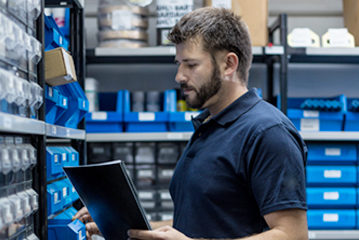
Visit Our Sponsors |
|
|
|
|
|
|
|
|
|
|
|
|
|
|
|
|
|
|
|
|
|
|
|
|
|
|
|
|
|
|
|
|
|
|
|
|
|
|


Whether to serve clients domestically or extend their reach globally, businesses need supply chain solutions like this. But how to make it happen?
Investing in new infrastructure is not necessarily the most feasible option. Third-party logistics services can be a viable alternative for companies wanting to scale up or down along with growth plans or fluctuations in demand. Particularly for companies managing high-volume aftersales service and repairs, accessing 3rd party warehousing and distribution, including strategically-located Field Stock Locations (FSLs) can help companies reach new customers in the U.S. and abroad, often with less capital outlay and risk.
Those providing after-sales service well know the challenges of getting the right product or service to a customer at the right time—not a moment late; not a moment too soon, either.
“Inventory optimization is important for all companies but those with high value products and high service-levels face even greater challenges,” says Dan Gagnon, VP for marketing at UPS Logistics & Distribution. “Network servers, for example often require inventory to be close-by to reduce expensive down time.” He adds, “The critical nature of those service networks puts inventory into the car trunks of service technicians and sales people. That contributes to under-reporting and the expense of dead stock.”
Gagnon adds that there are several reasons FSLs may be a good solution for service-focused companies. “Locally-stored inventory and inventory planning systems provide transparency so technicians can spend less time hauling, storing, and reconciling inventory and more time serving their customers and protecting the brand.” He adds, “A global network can relieve some of the day-to-day burdens from almost anywhere in the world.”
Gagnon speaks to the broad appeal of FSLs across multiple industries. “We operate FSLs worldwide for companies supplying parts or products for a range of industries, including high-tech manufacturers.”
The potential for new revenue – whether incremental business from a customer or the chance to reach new markets – presents a dilemma: Invest in a proactive ramp-up or risk scrambling at the last minute if a deal comes through? The former takes capital and manpower. The latter risks service levels and reputation.
Outsourcing to an experienced partner can be a good alternative. For example, a rapidly growing mobile device insurance and replacement company needed to improve time in transit to customers. UPS recommended moving the company’s inventory to UPS’s logistics and distribution campus near its worldwide hub in Louisville, Ky., UPS Worldport®. UPS now manages the movement of the company’s inventory from warehouse to consumer doorstep. When orders come into the company’s call centers as late as midnight, ET, UPS team members pick and pack the right stock for delivery as early as 10 a.m. the next morning. The arrangement also prepares the company’s logistics for the rapid growth of the business. Because UPS already has a world-class physical infrastructure, systems and process controls in place, the company is prepared to expand as quickly as needed.
An unsung benefit of working with a third-party is greater access solutions that may not be efficient for a company to implement on its own. Charlie Covert, Vice President of UPS Customer Solutions highlights some of the ways 3PLs can help companies respond to change more quickly and efficiently. “First and foremost, a third-party provider should offer advanced technology that integrates with your systems and improves visibility throughout your supply chain.”
Covert adds that it is also important to look at the full range of services a 3PL can offer. “Beyond basic FSL or warehousing capabilities, look for a provider with solutions that will give you an advantage in some way—in efficiency, or service-levels.”
He provides examples such as demand planning, inventory optimization, and even outside-the-box solutions like the UPS Access Point Network. “Access points are available to all customers, but our business customers also rely on thousands of UPS-authorized locations where technicians can pick-up and drop-off parts.”
Clearly, higher expectations for service are being met through an expanding range of strategically placed facilities. UPS’s Gagnon welcomes such growing decentralization of global logistics and distribution. “The localization of logistics is a sign that businesses are responding to their customers’ demands for more convenience and efficiency,” he says. “For many, working with a 3PL who has already invested in infrastructure is a great way to catch up with the speed of the global economy.”
[1] Christie Digital, “Christie Managed Services” (2016)
RELATED CONTENT
RELATED VIDEOS
Timely, incisive articles delivered directly to your inbox.

